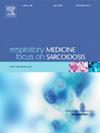Associations of small airway dysfunction assessed by impulse oscillometry with lung function decline and exacerbations in participants with chronic obstructive pulmonary disease: A prospective cohort study in China
IF 3.5
3区 医学
Q2 CARDIAC & CARDIOVASCULAR SYSTEMS
引用次数: 0
Abstract
Introduction
Small airway dysfunction (SAD) assessed by impulse oscillometry (IOS) was common in patients with chronic obstructive pulmonary disease (COPD). However, little is known about the associations between IOS-defined small airway dysfunction (SAD) and the long-term prognosis of COPD. This study aimed to explore the associations between IOS-defined SAD, lung function decline and exacerbations in patients with COPD.
Methods
We analyzed baseline and 2-year follow-up data from the prospective cohort study in China. We defined SAD using IOS parameters Z-score greater than the 1.645 or less than −1.645. Subsequently, these patients were divided into three groups based on the different criteria defined SAD using IOS (normal group [none IOS parameters abnormalities], inconsistent SAD [any IOS parameters abnormalities, but not all], consistent SAD [all of IOS parameters abnormalities]). Negative binomial regression was conducted to analyze the associations between SAD and exacerbations, while a multivariable linear regression model was utilized to identify associations between SAD and lung function decline.
Results
833 patients with COPD were enrolled in our study. SAD (defined by X5, AX, and Fres z-score) was associated with a faster decline in lung function and higher risk of exacerbation. Meanwhile, for inconsistent diagnosis of SAD, we observed that patients with consistent SAD and inconsistent SAD experienced a faster decline in FEV1 and higher risk of exacerbations than those with normal group.
Conclusions
IOS-defined SAD was associated with worse outcomes in patients with COPD, and further clinical trials are needed to clarify whether early intervention to reduce the severity of small airway lesions can delay the progress of COPD.
Trial registration
Chinese Clinical Trial Registry, ChiCTR1900024643. Registered on 19 July 2019.
慢性阻塞性肺疾病患者小气道功能障碍与肺功能下降和恶化的关联:中国的一项前瞻性队列研究
简介:慢性阻塞性肺病(COPD)患者中,通过脉冲振荡测量法(IOS)评估的小气道功能障碍(SAD)很常见。然而,人们对 IOS 界定的小气道功能障碍(SAD)与慢性阻塞性肺病长期预后之间的关系知之甚少。本研究旨在探讨慢性阻塞性肺病患者的 IOS 定义 SAD、肺功能下降和病情恶化之间的关系:我们分析了中国前瞻性队列研究的基线和两年随访数据。我们使用 IOS 参数 Z 值大于 1.645 或小于 -1.645 来定义 SAD。随后,根据使用 IOS 定义 SAD 的不同标准,这些患者被分为三组(正常组[无 IOS 参数异常]、不一致 SAD 组[有任何 IOS 参数异常,但不全是]、一致 SAD 组[所有 IOS 参数异常])。采用负二项回归分析 SAD 与病情恶化之间的关系,同时利用多变量线性回归模型确定 SAD 与肺功能下降之间的关系:我们的研究共纳入了 833 名慢性阻塞性肺病患者。SAD(以X5、AX和Fres z-score定义)与肺功能下降更快和病情恶化风险更高相关。同时,对于诊断不一致的 SAD,我们观察到,与正常组相比,诊断一致的 SAD 和诊断不一致的 SAD 患者的 FEV1 下降更快,病情恶化的风险更高:结论:IOS定义的SAD与慢性阻塞性肺病患者更差的预后相关,早期干预小气道的形成可能有效减缓慢性阻塞性肺病的进展:中国临床试验注册中心,ChiCTR1900024643。注册时间:2019年7月19日。
本文章由计算机程序翻译,如有差异,请以英文原文为准。
求助全文
约1分钟内获得全文
求助全文
来源期刊

Respiratory medicine
医学-呼吸系统
CiteScore
7.50
自引率
0.00%
发文量
199
审稿时长
38 days
期刊介绍:
Respiratory Medicine is an internationally-renowned journal devoted to the rapid publication of clinically-relevant respiratory medicine research. It combines cutting-edge original research with state-of-the-art reviews dealing with all aspects of respiratory diseases and therapeutic interventions. Topics include adult and paediatric medicine, epidemiology, immunology and cell biology, physiology, occupational disorders, and the role of allergens and pollutants.
Respiratory Medicine is increasingly the journal of choice for publication of phased trial work, commenting on effectiveness, dosage and methods of action.
 求助内容:
求助内容: 应助结果提醒方式:
应助结果提醒方式:


